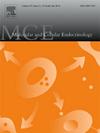MCC950通过NF-κB/c-FOS/NFATc1信号通路阻断NLRP3抑制破骨细胞生成,缓解糖尿病患者的骨质流失。
IF 3.8
3区 医学
Q2 CELL BIOLOGY
引用次数: 0
摘要
肥胖和 2 型糖尿病(T2DM)与骨质疏松症的发生有关,其中肥胖是 T2DM 的一个重要风险因素。肥胖的 T2DM 患者骨折率较高,骨折后的预后往往较差。为了满足了解糖尿病骨质疏松症(DOP)机制的迫切需要,目前正在开展研究,探索肥胖和 T2DM 如何影响骨代谢。NLRP3炎性体被认为与骨质疏松症的发病机制有关,NLRP3炎性体抑制剂MCC950已在多种疾病中显示出应用前景,但其在骨质疏松症中的作用仍有待探索。本研究分离并培养了BMMs和BMSCs,研究MCC950对骨代谢的影响,并利用DOP模型评估MCC950在体内的疗效。研究表明,MCC950能抑制破骨细胞的分化,降低BMMs的骨吸收能力,而不抑制BMSCs的成骨细胞分化。此外,MCC950 还抑制了 NF-κB 信号通路的激活,并下调了与破骨细胞分化相关的关键因子。此外,MCC950 还能缓解 DOP 小鼠的骨质流失。这些研究结果表明,MCC950通过靶向NLRP3炎性体,可在预防由T2DM合并肥胖诱发的骨质疏松症方面发挥保护作用。该研究强调了MCC950在控制糖尿病骨质疏松症方面的潜在治疗意义,并呼吁进一步研究其在高危患者群体中的临床应用。本文章由计算机程序翻译,如有差异,请以英文原文为准。
NLRP3 blockade by MCC950 suppressed osteoclastogenesis via NF-κB/c-Fos/NFATc1 signal pathway and alleviated bone loss in diabetes mellitus
Obesity and type 2 diabetes mellitus (T2DM) are linked to osteoporosis development, with obesity being a significant risk factor for T2DM. T2DM patients with obesity exhibit a higher fracture rate and often have a poor prognosis post-fracture. To address the urgent need for understanding the mechanisms of diabetic osteoporosis (DOP), research is ongoing to explore how obesity and T2DM impact bone metabolism. The NLRP3 inflammasome has been implicated in the pathogenesis of osteoporosis, and MCC950, an NLRP3 inflammasome inhibitor, has shown promise in various diseases but its role in osteoporosis remains unexplored. In this study, BMMs and BMSCs were isolated and cultured to investigate the effects of MCC950 on bone metabolism, and DOP model was used to evaluate the efficacy of MCC950 in vivo. The study demonstrated that MCC950 treatment inhibited osteoclast differentiation, reduced bone resorption capacity in BMMs without suppression for osteoblast differentiation from BMSCs. Additionally, MCC950 suppressed the activation of the NF-κB signaling pathway and downregulated key factors associated with osteoclast differentiation. Additionally, MCC950 alleviated bone loss in DOP mouse. These findings suggest that MCC950, by targeting the NLRP3 inflammasome, may have a protective role in preventing osteoporosis induced by T2DM with obesity. The study highlights the potential therapeutic implications of MCC950 in managing diabetic osteoporosis and calls for further research to explore its clinical application in high-risk patient populations.
求助全文
通过发布文献求助,成功后即可免费获取论文全文。
去求助
来源期刊

Molecular and Cellular Endocrinology
医学-内分泌学与代谢
CiteScore
9.00
自引率
2.40%
发文量
174
审稿时长
42 days
期刊介绍:
Molecular and Cellular Endocrinology was established in 1974 to meet the demand for integrated publication on all aspects related to the genetic and biochemical effects, synthesis and secretions of extracellular signals (hormones, neurotransmitters, etc.) and to the understanding of cellular regulatory mechanisms involved in hormonal control.
 求助内容:
求助内容: 应助结果提醒方式:
应助结果提醒方式:


